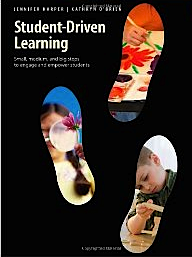Student-Driven Learning: Small, Medium, and Big Steps
Student-Driven Learning: Small, medium, and big steps to engage and empower students
By Jennifer Harper and Kathryn O’Brien
(Pembroke Publishers/Stenhouse, 2012 – Learn more)

Student-Driven Learning is a great introduction to what is also referred to as student centered learning where the learner takes center stage. It is learning that is driven by inquiry; the metaphor of the student being in the driver’s seat runs throughout the entire book.
Right from the beginning the reader is warned that this book is not about adding to our plates but about organizing what’s on the plate in order “to engage and support our students in discovery, problem-solving, and, most importantly, igniting the fire for lifelong learning,” (p. 6.) Furthermore, this book is written from the perspective that a world view based on knowledge as scarce vs. knowledge as being abundant is not the kind of world we want for our students; this is a theme that also runs throughout Will Richardson’s pithy but provocative TedTalk Book, Why Schools?

Furthermore, each chapter contains “postcards from the classroom” (examples of classrooms that are already employing student-centered learning) and “detours” (take us a little outside of the topic but are intended to provoke more thinking about teaching and learning practices).
Early on in the book, the authors ask readers the following question: what do we want our students to learn and what roles will teachers play in this new classroom where students are in the driver’s seat? Harper and O’Brien respond to their own question thus: “What we can do, as educators, is teach our students how to learn; we can instil a sense of inquiry and wonder. Rather than memorizing facts, our students will need to know how to source information,” (p. 16). And, as far as the new roles that teachers must play in this kind of classroom, there are many: facilitators or meddlers, skill developers, artists, resourcers, collaborators, and critical cheerleaders.
Ideas I’m eager to try out
Whenever I review a book, I am always on the lookout for how I can incorporate the author’s ideas into my own classroom. There were many sections in this book that I starred or checked off as activities or “moves” I would like to try out come September.
For example, one way to plan for and organize an inquiry study is to inform students of what they are expected to address based on curriculum documents; this could come at the beginning or at the end of an introduction into a topic of study. Expose students to the big ideas of a topic through books, videos, Internet sources, etc. Next, have students create questions about what they’re being exposed to. This will most likely lead to more reading and investigating. Finally, sort questions into days or weeks as a way of organizing the inquiry and post this where it’s visible to students. Of course, there are many teaching points that can be addressed along the way. For example, students need to be taught how to ask questions that will garner deeper meanings and understandings.
But, of course, before any of this can come to fruition, teachers need to create a community that welcomes all students and encourages taking risks, or having-a-go, as natural to the learning process; chapter three addresses different ways that teachers can get to know their students and create a classroom where students are passionate about learning. Chapter three also addresses diversity issues within the classroom and the importance of having close communication between the school and the home.
Student motivation
A book about student-driven learning wouldn’t be complete if it didn’t address the issue of intrinsic vs. extrinsic motivation. Although it seems that the authors aren’t firmly in one camp or the author, it seems clear that they would support an environment that trusts students to direct their own learning with teachers serving the role of facilitators and meddlers, as previously mentioned. And so there is an entire section devoted to encouraging students to be autonomous by providing choice, structure, trusting the process, providing time, making space, and creating access to a variety of tools so that students can conduct their own learning journeys. And, of course, a classroom that supports autonomy for students also makes room for collaboration. According to the authors, “Collaboration builds on autonomy. If autonomy means giving our students ownership of their learning, then collaboration means giving our students the resources to build their learning,” (p.73).
A classroom that supports student-driven learning is ripe with opportunities for creativity and critical thinking to blossom. The authors address each of these topics in separate chapters with lots of ideas so that teachers can foster this kind of mindset in the classroom.
The final chapter, ‘The Learning Map,’ tries to put all of the previous chapters together into one roadmap to help teachers organize for a student-driven classroom. In addition, the appendix provides some templates that teachers may use for this purpose, including several different student planners so that students can map out their learning journey.
I highly recommend this book to teachers who want to move in the direction of a classroom where students are in the driver’s seat by analyzing how they currently structure teaching and learning. You won’t be disappointed!
Elisa Waingort has been teaching in bilingual settings for more than 25 years in public and international schools in North and South America. She is currently teaching ESL in middle school at Academia Cotopaxi, an American International School in Quito, Ecuador. Elisa blogs at A Teacher’s Ruminations and is a member of Cooperative Catalyst. She is also a member of the Elementary Section Steering Committee of the National Council of Teachers of English and serves on NCTE’s Executive Committee. She’s also uncovering Twitter’s power @elisaw5.


































